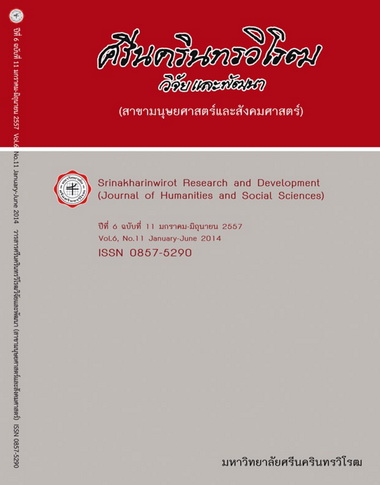ปัญหาในการฟังและการใช้กลวิธีที่ช่วยในการฟังของนักศึกษาระดับ มหาวิทยาลัย LISTENING DIFFICULTIES AND STRATEGY USE BY UNIVERSITY STUDENTS
Keywords:
Listening Difficulties, Listening StrategiesAbstract
บทคัดย่อ
การวิจัยเชิงสำรวจนี้มีจุดมุ่งหมายเพื่อหาความแตกต่างของปัญหาในการฟังที่เกิดขึ้นระหว่าง
นักเรียนที่มีความสามารถในการฟังสูงกว่าและนักเรียนที่มีความสามารถในการฟังต่ำกว่า และเพื่อหา
ความสัมพันธ์ระหว่างปัญหาในการฟังและกลวิธีที่ช่วยในการฟัง กลุ่มตัวอย่างที่ใช้ในการวิจัยครั้งนี้คือ
นักศึกษาชั้นปีที่ 3 เอกภาษาอังกฤษของมหาวิทยาลัยรัฐบาล 4 แห่งในจังหวัดสงขลา โดยคัดเลือก
กลุ่มตัวอย่างจากนักศึกษา จำนวน 143 คน และนำมาแบ่งออกเป็น 2 กลุ่ม กลุ่มละ 39 คนตามระดับ
ความสามารถ โดยใช้เทคนิค 27% เครื่องมือที่ใช้ในการศึกษาค้นคว้า ได้แก่ แบบสอบถามเกี่ยวกับปัญหาในการฟังและแบบวัดกลวิธีที่ช่วยการฟัง (Strategy Inventory of Language Learning) ซึ่งดัดแปลงจากต้นฉบับของ Rebecca Oxford [1] และแบบทดสอบการฟังจากหนังสือ IELTS Practice Listening Test เพื่อใช้ในการแบ่งกลุ่มความสามารถของกลุ่มตัวอย่าง แล้วนำข้อมูลที่ได้มาประมวลผลโดยการหาค่าเฉลี่ย ค่าเบี่ยงเบนมาตรฐาน ค่าร้อยละ ความแตกต่างของค่าเฉลี่ย (t-test) และค่าสัมประสิทธิ์สหสัมพันธ์แบบเพียร์สัน (the Pearson Correlation Coefficient) ผลการวิจัยพบว่าปัญหาในการฟังของกลุ่มตัวอย่างทั้ง 2 กลุ่มไม่แตกต่างกันอย่างมีนัยสำคัญทางสถิติ แต่พบความสัมพันธ์กันอย่างมีนัยสำคัญระหว่างปัญหาการฟังบางประการกับการเลือกใช้กลวิธีที่ช่วยในการฟังของกลุ่มตัวอย่างทั้ง 2 กลุ่ม
Abstract
The purposes of this survey research were to investigate the differences in listening difficulties occurring to students with more and less listening ability and to find out the relationships between listening difficulties and their choices of listening strategies. The subjects were 78 third-year undergraduate students, majoring in English from 4 public universities in Songkhla province, Thailand. The population of 143 was divided into 2 proficiency groups of 39 each: more and less able levels, using the 27% technique. The instruments included the
Questionnaire on Listening Difficulties and Strategies and IELTS Practice Listening Test [2] which were given to divide the groups of subjects. The data were analyzed using mean, standard deviation, percentage, t-test and the Pearson Correlation Coefficient. The findings revealed no significant differences in listening difficulties between students with more and less ability in listening (t = -1.02, p> 0.05), but showed significant negative and positive correlations between some of the listening difficulties and choice of strategies of the groups of subjects respectively.
Downloads
Downloads
Published
How to Cite
Issue
Section
License
Srinakharinwirot Research and Development Journal of Humanities and Social Sciences is licensed Under a Creative Commons Attribution-NonCommercial-NoDerivs 4.0 International (CC-BY-NC-ND 4.0) License, Unless Otherwise Stated. Please Read Journal Policies Page for More Information on Open Access, Copyright and Permissions.



